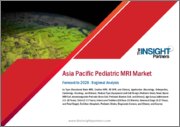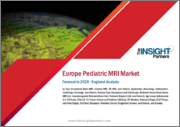
|
시장보고서
상품코드
1394061
북미의 소아용 MRI 시장 예측(-2028년) : 지역별 분석 - 유형, 용도, 제품 유형, 연령대, 최종 사용자별North America Pediatric MRI Market Forecast to 2028 - Regional Analysis - by Type, Application, Product Type, Age Group, and End User |
||||||
북미의 소아용 MRI 시장은 2022년 16억 3,362만 달러로 평가되었고, 2028년에는 25억 6,712만 달러에 달할 것으로 예상되며, 2022년부터 2028년까지 연평균 7.8%의 성장률을 보일 것으로 예상됩니다.
환자 치료 개선을 위한 디지털 의료 기술 도입으로 북미의 소아용 MRI 시장 성장 견인
병원, 소아과 등 의료 환경에서의 첨단 기술 도입이 지역 전체에서 증가하고 있으며, 이를 통해 환자의 안전을 개선하고 전반적인 입원 기간과 입원 기간을 최소화하고 있습니다. 인공지능(AI), 머신러닝(ML), 사물인터넷(IoT) 및 기타 신기술을 헬스케어, 의료 및 과학 연구에 도입하는 것이 점점 더 중요해지고 있습니다. 센서의 소형화 및 기타 기술의 발전은 임상시험에 참여하는 환자(특히 소아)로부터 생리적 및 기능적 데이터를 직접 수집할 수 있는 기회를 제공합니다. 센서는 휴대폰 및 기타 디지털 플랫폼과 함께 소아과 영역에서 임상시험 치료에 대한 환자의 반응을 평가할 수 있는 다재다능한 도구가 될 수 있습니다.
코로나19 사태 이후 정신 건강 문제로 고통받는 어린이들의 수가 급증하고 있는 가운데, 2022년 10월 미국 대통령은 소아 정신 의료 접근성 보상 프로그램을 확대하는 것을 우선순위에 두겠다고 발표했습니다. 이 프로그램을 통해 소아 의료 서비스 제공업체는 전문적인 정신 건강 관리를 위한 원격 의료 서비스를 받을 수 있게 됩니다. 어린 환자들이 치료 중 불안과 스트레스를 느끼는 것은 흔한 일이기 때문에 샌포드 어린이 병원, 어린이 메모리얼 허먼 병원, 어린이 미네소타 병원과 같은 일부 어린이 병원에서는 치료와 치료를 받는 환자를 즐겁게 하고 주의를 분산시키기 위해 대화형 환자 참여 기술을 사용하고 있습니다. 대화형 환자 참여형 기술을 사용하고 있습니다. 앱은 부모가 자녀의 건강 기록과 추가 정보에 액세스하는 데 도움이 될 수 있습니다. 예를 들어, CDC가 개발한 앱 'Milestone Tracker'는 2-5세 사이의 자녀가 제대로 성장하고 있는지 확인할 수 있는 체크리스트를 부모에게 제공합니다. 마찬가지로, SoftSpot은 AI와 컴퓨터 비전(CV) 기술이 탑재된 FDA 승인 의료보험 상호운용성 및 책임에 관한 법률(HIPAA)을 준수하는 앱입니다. 이 앱은 신생아의 두개골을 측정하여 사두증과 사두증 사례를 감지합니다.
2017년 3월, 로얄 Philips와 피닉스 어린이 병원은 6,500만 달러 상당의 15년 계약을 발표했습니다. 피닉스 어린이 병원과 로열 Philips는 이 지역 전체 공장 표준인 소아용 MRI 프로토콜에 따라 선량 감소 시스템 및 기타 기술을 개발했습니다. 또한 MRI를 사용하여 심장 및 뇌 생리학을 연구하기 위해 환자의 실물 크기 모델을 구축하는 첨단 3D 프린팅 실험실을 갖추고 있습니다. 또한, 첨단 MRI 기술에 대한 연구도 지역 전체에서 증가하고 있습니다. 예를 들어, 2019년 9월, 콜로라도대학교 의과대학 연구진은 "고속 MRI"라는 새로운 영상 진단 방법을 확인했습니다. 이 방법은 소아의 외상성 뇌손상(TBI)을 분석하는 데 효과적이며, 방사선 노출 및 마취와 관련된 위험을 제거할 수 있습니다.
이러한 이유로 북미의 소아용 MRI 시장의 성장을 견인하는 것은 헬스케어 분야에서의 신기술 도입입니다.
북미의 소아용 MRI 시장 개요
북미의 소아용 MRI 시장은 미국, 캐나다, 멕시코 등 주요 3개 국가로 구분됩니다. 미국은 소아 질환의 부담 증가, 제품 출시 수 증가, 첨단 소아용 MRI 장비 개발을 위한 R&D 활동 증가 등의 요인으로 인해 가장 큰 시장 점유율을 차지하고 있습니다. 미숙아 출산 증가, 소아 질환 유병률 증가, 예방 의료 및 영상 솔루션에 대한 높은 수요가 소아 영상 시스템 수요를 견인하고 있습니다. 미국 질병예방통제센터(CDC)에 따르면, 미국에서 약 920만 명의 어린이가 낙상, 교통사고, 화상 등 불의 부상으로 응급실에 입원합니다. 외상 사례 증가는 MRI 솔루션에 대한 수요를 촉진하고 있습니다.
2028년까지 북미의 소아용 MRI 시장 수익 및 전망
북미의 소아용 MRI 시장 세분화
북미의 소아용 MRI 시장은 유형, 용도, 제품 유형, 연령대, 최종 사용자, 국가별로 분류됩니다. 유형별로 북미의 소아용 MRI 시장은 뇌 기능 MRI, 심장 MRI, 4D MRI, 기타로 분류됩니다. 뇌기능 MRI 분야가 2022년 가장 큰 시장 점유율을 차지했습니다.
용도별로는 북미의 소아용 MRI 시장은 신경학, 정형외과, 심장학, 종양학, 기타로 구분되며, 2022년에는 신경학 분야가 가장 큰 시장 점유율을 차지할 것으로 예상됩니다.
제품 유형별로는 북미의 소아용 MRI 시장은 장비와 코일 설계로 나뉘며, 2022년 시장 점유율은 장비 분야가 더 큽니다.
연령대별로 북미의 소아용 MRI 시장은 사춘기(11-18세), 소아(2-11세), 영아(생후 28일-23개월), 신생아(0-27일), 태아로 구분됩니다. 청소년기(11-18세) 부문이 2022년 가장 큰 시장 점유율을 차지했습니다.
최종 사용자별로 북미의 소아용 MRI 시장은 병원, 소아과 진료소, 진단센터, 기타로 구분됩니다. 병원 부문이 2022년 가장 큰 시장 점유율을 차지했습니다.
국가별로는 북미의 소아용 MRI 시장은 미국, 캐나다, 멕시코로 구분되며, 2022년 북미의 소아용 MRI 시장 점유율은 미국이 독주했습니다.
Advanced Imaging Research Inc, Aspect Imaging Ltd, GE HealthCare Technologies Inc, Hyperfine Inc, Koninklijke Philips NV, LMT Medical Systems GmbH NORAS MRI products GmbH, Siemens Healthineers AG, Time Medical Holding은 북미의 소아용 MRI 시장의 주요 기업입니다.
목차
제1장 서론
제2장 주요 포인트
제3장 조사 방법
- 조사 범위
- 2차 조사
- 1차 조사
제4장 북미의 소아용 MRI 시장 - 시장 구도
- 개요
- PEST 분석
- 북미의 PEST 분석
- 전문가의 견해
제5장 북미의 소아용 MRI 시장 - 주요 시장 역학
- 시장 성장 촉진요인
- 시장 성장 억제요인
- 시장 기회
- 향후 동향
- 영향 분석
제6장 소아용 MRI 시장 - 북미 분석
- 북미의 소아용 MRI 시장 매출 예측과 분석
제7장 북미의 소아용 MRI 시장 - 2028년까지 매출과 예측 : 유형별
- 시장 개요
- 소아용 MRI 시장 유형별 매출 점유율(2022년, 2028년)
- 뇌기능 MRI(fMRI)
- 심장 MRI
- 4D MRI
- 기타
제8장 북미의 소아용 MRI 시장 : 매출과 예측(-2028년) : 용도별
- 소아용 MRI 시장 매출 점유율, 용도별(2022년, 2028년)
- 신경학
- 정형외과
- 심장병학
- 종양학
- 기타
제9장 북미의 소아용 MRI 시장 : 매출과 예측(-2028년) : 제품 유형별
- 소아용 MRI 시장 매출 점유율, 제품 유형별(2022년, 2028년)
- 장비
- 코일 설계
제10장 북미의 소아용 MRI 시장 : 매출과 예측(-2028년) : 연령층별
- 소아용 MRI 시장 점유율, 연령층별(2022년 및 2028년)
- 태아기
- 신생아기(0-27일)
- 유아기(28일-23개월)
- 소아기(2-11세)
- 청년기(12-18세)
제11장 북미의 소아용 MRI 시장 : 매출과 예측(-2028년) : 최종사용자별
- 소아용 MRI 시장 점유율, 최종사용자별(2022년, 2028년)
- 병원
- 소아과 클리닉
- 진단센터
- 기타
제12장 북미의 소아용 MRI 시장 : 매출과 예측(-2028년) : 국가별 분석
- 북미
제13장 북미의 소아용 MRI 시장 - 업계 상황
- 소아용 MRI 시장 성장 전략
- 유기적 성장 전략
- 무기적 성장 전략
- 성장 전략
제14장 기업 개요
- Siemens Healthineers AG
- Advanced Imaging Research Inc
- LMT Medical Systems GmbH
- Hyperfine Inc
- GE HealthCare Technologies Inc
- Aspect Imaging Ltd
- NORAS MRI products GmbH
- Koninklijke Philips NV
- Time Medical Holding
제15장 부록
LSH 23.12.19The North America pediatric MRI market was valued at US$ 1,633.62 million in 2022 and is expected to reach US$ 2,567.12 million by 2028; it is estimated to grow at a CAGR of 7.8% from 2022 to 2028.
Adoption of Digital Health Technology to Improve Patient Care fueling the North America Pediatric MRI Market
The adoption of advanced technologies in healthcare settings, such as hospitals and pediatric specialty clinics, is increasing across the region, improving patient safety and minimizing the overall turnaround time and hospital stay. The incorporation of artificial intelligence (AI), machine learning (ML), the Internet of Things (IoT), and other new technologies in healthcare, medicine, and scientific research has become increasingly important. Advancements in the miniaturization of sensors and other technologies also offer opportunities to collect physiological and functional data directly from patients participating in clinical trials, especially in children. Along with cell phones and other digital platforms, sensors provide a versatile tool for assessing patient responses to investigational treatments in the field of pediatrics.
Since the COVID-19 pandemic, the number of children suffering from mental health problems have increased rapidly. In October 2022, the President of the US announced prioritizing the expansion of the Pediatric Mental Health Care Access Awards program. The program allows pediatric care providers to ensure telehealth services for expert mental health care. As it is normal for young patients to feel anxious or stressed during treatment, several children's hospitals, such as Sanford Children's, Children's Memorial Hermann, and Children's Minnesota, use interactive patient engagement technology to entertain and distract patients undergoing medical procedures or treatments. Apps can help parents access their children's health records and additional information. For example, Milestone Tracker, an app developed by CDC, provides checklists for parents to ensure their children are developing properly between the ages of 2-5. Similarly, SoftSpot is an FDA-approved and the Health Insurance Portability and Accountability Act (HIPAA)-compliant app powered by AI and Computer Vision (CV) technology. The app measure's the skulls of newborn babies to detect cases of plagiocephaly or brachycephaly.
In March 2017, Royal Philips and Phoenix Children's Hospital announced a 15-year agreement worth US$ 65 million. Phoenix Children's and Royal Philips developed dose reduction systems and other technologies that follow pediatric MRI protocols, which are factory standards across the region. They also have an advanced 3D print laboratory that constructs life-size models of patients to study heart and brain physiology using MRI. Furthermore, research on advanced MRI technologies is also increasing across the region. For instance, in September 2019, researchers from the University of Colorado School of Medicine identified a new imaging method named "fast MRI." The method is effective in analyzing pediatric traumatic brain injuries (TBI), thereby eliminating risks related to radiation exposure and anesthesia.
Therefore, the adoption of new technologies in healthcare is driving the growth of the North America pediatric MRI market .
North America Pediatric MRI Market Overview
The North America pediatric MRI market is segmented into three major countries-the US, Canada, and Mexico. The US holds the largest market share owing to factors such as the increasing burden of pediatric diseases, rising number of product launches, and growing R&D activities to develop advanced pediatric MRI devices. The rising number of premature births, increasing prevalence of pediatric diseases, and high demand for preventive care and imaging solutions drive the demand for pediatric imaging systems. According to the Centers for Disease Control and Prevention (CDC), around 9.2 million children in the US are admitted to the emergency department due to accidental injuries caused by falls, road traffic accidents, and burns. Increasing cases of traumatic injuries propel the demand for MRI solutions.
North America Pediatric MRI Market Revenue and Forecast to 2028 (US$ Million)
North America Pediatric MRI Market Segmentation
The North America pediatric MRI market is segmented based on type, application, product type, age group, end user, and country. Based on type, the North America pediatric MRI market is segmented into functional brain MRI, cardiac MRI, 4D MRI, and others. The functional brain MRI segment held the largest market share in 2022.
Based on application, the North America pediatric MRI market is segmented into neurology, orthopedics, cardiology, oncology, and others. The neurology segment held the largest market share in 2022.
Based on product type, the North America pediatric MRI market is bifurcated into equipment and coil design. The equipment segment held a larger market share in 2022.
Based on age group, the North America pediatric MRI market is segmented into adolescent (11-18 Years), child (2-11 Years), infants and toddlers (28 Days-23 Months), neonatal stage (0-27 Days), and fetal stage. The adolescent (11-18 Years) segment held the largest market share in 2022.
Based on end user, the North America pediatric MRI market is segmented into hospitals, pediatric clinics, diagnostic centers, and others. The hospitals segment held the largest market share in 2022.
Based on country, the North America pediatric MRI market is segmented into the US, Canada, and Mexico. The US dominated the North America pediatric MRI market share in 2022.
Advanced Imaging Research Inc; Aspect Imaging Ltd; GE HealthCare Technologies Inc; Hyperfine Inc; Koninklijke Philips NV; LMT Medical Systems GmbH; NORAS MRI products GmbH; Siemens Healthineers AG; and Time Medical Holding are some of the leading players operating in the North America pediatric MRI market.
Reasons to Buy:
- Save and reduce time carrying out entry-level research by identifying the growth, size, leading players, and segments in the North America pediatric MRI market.
- Highlights key business priorities in order to assist companies to realign their business strategies
- The key findings and recommendations highlight crucial progressive industry trends in the North America pediatric MRI market, thereby allowing players across the value chain to develop effective long-term strategies
- Develop/modify business expansion plans by using substantial growth offering developed and emerging markets
- Scrutinize in-depth North America market trends and outlook coupled with the factors driving the North America pediatric MRI market, as well as those hindering it
- Enhance the decision-making process by understanding the strategies that underpin commercial interest with respect to client products, segmentation, pricing, and distribution
Table Of Contents
1. Introduction
- 1.1 Scope of the Study
- 1.2 The Insight Partners Research Report Guidance
- 1.3 Market Segmentation
- 1.3.1 North America Pediatric MRI Market - By Type
- 1.3.2 North America Pediatric MRI Market - By Application
- 1.3.3 North America Pediatric MRI Market - By Product Type
- 1.3.4 North America Pediatric MRI Market - By Age Group
- 1.3.5 North America Pediatric MRI Market - By End User
- 1.3.6 North America Pediatric MRI Market- By Country
2. Key Takeaways
3. Research Methodology
- 3.1 Coverage
- 3.2 Secondary Research
- 3.3 Primary Research
4. North America Pediatric MRI Market- Market Landscape
- 4.1 Overview
- 4.2 PEST Analysis
- 4.2.1 North America - PEST Analysis
- 4.3 Experts Opinion
5. North America Pediatric MRI Market - Key Market Dynamics
- 5.1 Market Drivers
- 5.1.1 The Rising Number of Premature Births, and Pediatric Diseases
- 5.1.2 Adoption of Digital Health Technology to Improve Patient Care
- 5.2 Market Restraints
- 5.2.1 Limitations and Safety Challenges Associated with Pediatric MRI
- 5.3 Market Opportunities
- 5.3.1 Increasing Campaigns to Create Awareness Regarding Pediatric Safety
- 5.4 Future Trends
- 5.4.1 Use of MRI Simulators to Adapt Children to MRI Scanners
- 5.5 Impact Analysis
6. Pediatric MRI Market- North America Analysis
- 6.1 North America Pediatric MRI Market Revenue Forecast and Analysis
7. North America Pediatric MRI Market - Revenue and Forecast to 2028 - by Type
- 7.1 Overview
- 7.2 Pediatric MRI Market Revenue Share, by Type (2022 and 2028)
- 7.3 Functional Brain MRI (fMRI)
- 7.3.1 Overview
- 7.3.2 Functional Brain MRI (fMRI): Pediatric MRI Market - Revenue and Forecast to 2028 (US$ Million)
- 7.4 Cardiac MRI
- 7.4.1 Overview
- 7.4.2 Cardiac MRI: Pediatric MRI Market - Revenue and Forecast to 2028 (US$ Million)
- 7.5 4D MRI
- 7.5.1 Overview
- 7.5.2 4D MRI: Pediatric MRI Market - Revenue and Forecast to 2028 (US$ Million)
- 7.6 Others
- 7.6.1 Overview
- 7.6.2 Others: Pediatric MRI Market - Revenue and Forecast to 2028 (US$ Million)
8. North America Pediatric MRI Market - Revenue and Forecast to 2028- By Application
- 8.1 Overview
- 8.2 Pediatric MRI Market Revenue Share, by Application (2022 and 2028)
- 8.3 Neurology
- 8.3.1 Overview
- 8.3.2 Neurology: Pediatric MRI Market - Revenue and Forecast to 2028 (US$ Million)
- 8.4 Orthopedics
- 8.4.1 Overview
- 8.4.2 Orthopedics: Pediatric MRI Market - Revenue and Forecast to 2028 (US$ Million)
- 8.5 Cardiology
- 8.5.1 Overview
- 8.5.2 Cardiology: Pediatric MRI Market - Revenue and Forecast to 2028 (US$ Million)
- 8.6 Oncology
- 8.6.1 Overview
- 8.6.2 Oncology: Pediatric MRI Market - Revenue and Forecast to 2028 (US$ Million)
- 8.7 Others
- 8.7.1 Overview
- 8.7.2 Others: Pediatric MRI Market - Revenue and Forecast to 2028 (US$ Million)
9. North America Pediatric MRI Market - Revenue and Forecast to 2028- By Product Type
- 9.1 Overview
- 9.2 Pediatric MRI Market Revenue Share, by Product Type (2022 and 2028)
- 9.3 Equipment
- 9.3.1 Overview
- 9.3.2 Equipment: Pediatric MRI Market - Revenue and Forecast to 2028 (US$ Million)
- 9.4 Coil Design
- 9.4.1 Overview
- 9.4.2 Coil Design: Pediatric MRI Market - Revenue and Forecast to 2028 (US$ Million)
- 9.4.3 Pediatric Head/Neck/Spine (HNS) MRI Coil
- 9.4.3.1 Overview
- 9.4.3.2 Pediatric Head/Neck/Spine (HNS) MRI Coil: Pediatric MRI Market - Revenue and Forecast to 2028 (US$ Million)
- 9.4.4 Pediatric Blanket Coil
- 9.4.4.1 Overview
- 9.4.4.2 Pediatric Blanket Coil: Pediatric MRI Market - Revenue and Forecast to 2028 (US$ Million)
- 9.4.5 Interchangeable Pediatric Brain Coil Set
- 9.4.5.1 Overview
- 9.4.5.2 Specifications of the Three Types of Interchangeable Pediatric Brain Coils
- 9.4.5.3 Interchangeable Pediatric Brain Coil Set: Pediatric MRI Market - Revenue and Forecast to 2028 (US$ Million)
- 9.4.6 Others
- 9.4.6.1 Overview
- 9.4.6.2 Others: Pediatric MRI Market - Revenue and Forecast to 2028 (US$ Million)
10. North America Pediatric MRI Market - Revenue and Forecast to 2028- By Age Group
- 10.1 Overview
- 10.2 Pediatric MRI Market Share, by Age Group, 2022 and 2028, (%)
- 10.3 Fetal Stage
- 10.3.1 Overview
- 10.3.2 Fetal Stage: Pediatric MRI Market - Revenue and Forecast to 2028 (US$ Million)
- 10.4 Neonatal Stage (0-27 Days)
- 10.4.1 Overview
- 10.4.2 Neonatal Stage: Pediatric MRI Market - Revenue and Forecast to 2028 (US$ Million)
- 10.5 Infant and Toddler (28 Days To 23 Months)
- 10.5.1 Overview
- 10.5.2 Infant and Toddler: Pediatric MRI Market- Revenue and Forecast to 2028 (US$ Million)
- 10.6 Child (2-11 Years)
- 10.6.1 Overview
- 10.6.2 Child: Pediatric MRI Market - Revenue and Forecast to 2028 (US$ Million)
- 10.7 Adolescents (12 To 18 Years)
- 10.7.1 Overview
- 10.7.2 Adolescents: Pediatric MRI Market - Revenue and Forecast to 2028 (US$ Million)
11. North America Pediatric MRI Market - Revenue and Forecast to 2028- By End User
- 11.1 Overview
- 11.2 Pediatric MRI Market Share, by End User, 2022 and 2028, (%)
- 11.3 Hospitals
- 11.3.1 Overview
- 11.3.2 Hospitals: Pediatric MRI Market - Revenue and Forecast to 2028 (US$ Million)
- 11.4 Pediatric Clinics
- 11.4.1 Overview
- 11.4.2 Pediatric Clinics: Pediatric MRI Market - Revenue and Forecast to 2028 (US$ Million)
- 11.5 Diagnostic Centres
- 11.5.1 Overview
- 11.5.2 Diagnostic Centres: Pediatric MRI Market - Revenue and Forecast to 2028 (US$ Million)
- 11.6 Others
- 11.6.1 Overview
- 11.6.2 Others: Pediatric MRI Market - Revenue and Forecast to 2028 (US$ Million)
12. North America Pediatric MRI Market - Revenue and Forecast to 2028 - by Country Analysis
- 12.1 North America: Pediatric MRI Market
- 12.1.1 Overview
- 12.1.2 North America: Pediatric MRI Market, by Country, 2022 & 2028 (%)
- 12.1.2.1 US: Pediatric MRI Market- Revenue and Forecast to 2028 (USD Million)
- 12.1.2.1.1 Overview
- 12.1.2.1.2 US: Pediatric MRI Market, Number of Anatomy Scans
- 12.1.2.1.3 US: Pediatric MRI Market - Revenue and Forecast to 2028 (USD Million)
- 12.1.2.1.4 US: Pediatric MRI Market, by Type, 2020-2028 (USD Million)
- 12.1.2.1.5 US: Pediatric MRI Market, by Application, 2020-2028 (USD Million)
- 12.1.2.1.6 US: Pediatric MRI Market, by Product Type, 2020-2028 (USD Million)
- 12.1.2.1.6.1 US: Pediatric MRI Market, by Coil Design, 2020-2028 (USD Million)
- 12.1.2.1.7 US: Pediatric MRI Market, by Age Group, 2020-2028 (USD Million)
- 12.1.2.1.8 US: Pediatric MRI Market, by End User, 2020-2028 (USD Million)
- 12.1.2.2 Canada: Pediatric MRI Market - Revenue and Forecast to 2028 (USD Million)
- 12.1.2.2.1 Overview
- 12.1.2.2.2 Canada: Pediatric MRI Market, Number of Anatomy Scans
- 12.1.2.2.3 Canada: Pediatric MRI Market - Revenue and Forecast to 2028 (USD Million)
- 12.1.2.2.4 Canada: Pediatric MRI Market, by Type, 2020-2028 (USD Million)
- 12.1.2.2.5 Canada: Pediatric MRI Market, by Application, 2020-2028 (USD Million)
- 12.1.2.2.6 Canada: Pediatric MRI Market, by Product Type, 2020-2028 (USD Million)
- 12.1.2.2.6.1 Canada: Pediatric MRI Market, by Coil Design, 2020-2028 (USD Million)
- 12.1.2.2.7 Canada: Pediatric MRI Market, by Age Group, 2020-2028 (USD Million)
- 12.1.2.2.8 Canada: Pediatric MRI Market, by End User, 2020-2028 (USD Million)
- 12.1.2.3 Mexico: Pediatric MRI Market - Revenue and Forecast to 2028 (USD Million)
- 12.1.2.3.1 Overview
- 12.1.2.3.2 Mexico: Pediatric MRI Market, Number of Anatomy Scans
- 12.1.2.3.3 Mexico: Pediatric MRI Market - Revenue and Forecast to 2028 (USD Million)
- 12.1.2.3.4 Mexico: Pediatric MRI Market, by Type - 2020-2028 (USD Million)
- 12.1.2.3.5 Mexico: Pediatric MRI Market, by Application, 2020-2028 (USD Million)
- 12.1.2.3.6 Mexico: Pediatric MRI Market, by Product Type, 2020-2028 (USD Million)
- 12.1.2.3.6.1 Mexico: Pediatric MRI Market, by Coil Design, 2020-2028 (USD Million)
- 12.1.2.3.7 Mexico: Pediatric MRI Market, by Age Group, 2020-2028 (USD Million)
- 12.1.2.3.8 Mexico: Pediatric MRI Market, by End User, 2020-2028 (USD Million)
- 12.1.2.1 US: Pediatric MRI Market- Revenue and Forecast to 2028 (USD Million)
13. North America Pediatric MRI Market-Industry Landscape
- 13.1 Overview
- 13.2 Growth Strategies in Pediatric MRI Market
- 13.3 Organic Growth Strategies
- 13.3.1 Overview
- 13.4 Inorganic Growth Strategies
- 13.4.1 Overview
14. Company Profiles
- 14.1 Siemens Healthineers AG
- 14.1.1 Key Facts
- 14.1.2 Business Description
- 14.1.3 Products and Services
- 14.1.4 Financial Overview
- 14.1.5 SWOT Analysis
- 14.1.6 Key Developments
- 14.2 Advanced Imaging Research Inc
- 14.2.1 Key Facts
- 14.2.2 Business Description
- 14.2.3 Products and Services
- 14.2.4 Financial Overview
- 14.2.5 SWOT Analysis
- 14.2.6 Key Developments
- 14.3 LMT Medical Systems GmbH
- 14.3.1 Key Facts
- 14.3.2 Business Description
- 14.3.3 Products and Services
- 14.3.4 Financial Overview
- 14.3.5 SWOT Analysis
- 14.3.6 Key Developments
- 14.4 Hyperfine Inc
- 14.4.1 Key Facts
- 14.4.2 Business Description
- 14.4.3 Products and Services
- 14.4.4 Financial Overview
- 14.4.5 SWOT Analysis
- 14.4.6 Key Developments
- 14.5 GE HealthCare Technologies Inc
- 14.5.1 Key Facts
- 14.5.2 Business Description
- 14.5.3 Products and Services
- 14.5.4 Financial Overview
- 14.5.5 SWOT Analysis
- 14.5.6 Key Developments
- 14.6 Aspect Imaging Ltd
- 14.6.1 Key Facts
- 14.6.2 Business Description
- 14.6.3 Products and Services
- 14.6.4 Financial Overview
- 14.6.5 SWOT Analysis
- 14.6.6 Key Developments
- 14.7 NORAS MRI products GmbH
- 14.7.1 Key Facts
- 14.7.2 Business Description
- 14.7.3 Products and Services
- 14.7.4 Financial Overview
- 14.7.5 SWOT Analysis
- 14.7.6 Key Developments
- 14.8 Koninklijke Philips NV
- 14.8.1 Key Facts
- 14.8.2 Business Description
- 14.8.3 Products and Services
- 14.8.4 Financial Overview
- 14.8.5 SWOT Analysis
- 14.8.6 Key Developments
- 14.9 Time Medical Holding
- 14.9.1 Key Facts
- 14.9.2 Business Description
- 14.9.3 Products and Services
- 14.9.4 Financial Overview
- 14.9.5 SWOT Analysis
- 14.9.6 Key Developments
15. Appendix
- 15.1 About The Insight Partners
- 15.2 Glossary of Terms
















